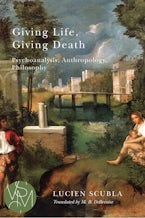Although women alone have the ability to bring children into the world, modern Western thought tends to discount this female prerogative. In Giving Life, Giving Death, Lucien Scubla argues that structural anthropology sees women as objects of exchange that facilitate alliance-building rather than as vectors of continuity between generations. Examining the work of Lévi-Strauss, Freud, and Girard, as well as ethnographic and clinical data, Giving Life, Giving Death seeks to explain why, in constructing their master theories, our greatest thinkers have consistently marginalized the cultural and biological fact of maternity. In the spirit of Freud’s Totem and Taboo, Scubla constructs an anthropology that posits a common source for family and religion. His wide-ranging study explores how rituals unite violence and the sacred and intertwine the giving of death and the giving of life.
ContentsPrefaceAcknowledgmentsChapter 1. Freud and the Oedipus LegendChapter 2. Procreation and Headhunting: Fatherhood among the MarindChapter 3. The Guardians of Dogma: Jones, Malinowski, and the Maternal UncleChapter 4. The Atom of Kinship, or the Absent MotherChapter 5. Incest of the Second Type: Impasses and IssuesChapter 6. The Brother-Sister Relationship and the Principle of Male DominanceChapter 7. Conceptualizing Difference or Dissolving Hierarchy?: From Asymmetry to ParityChapter 8. Testart’s Law: Division of Labor and Sexual IdentityChapter 9. Nature and Culture: The Return of the Sophists in Western ThoughtChapter 10. Reik, Guardian of Dogma: Couvade, Initiation Rites, and the Oedipus ComplexChapter 11. Hierarchy of the Sexes and Hierarchy of Knowledge, or Plato among the BaruyaChapter 12. Ethnology and Psychology in Róheim and Devereux: Identity, Homology, or Complementarity?Chapter 13. Should Totem and Taboo Simply Be Forgotten?Chapter 14. Freud, in Spite of EverythingChapter 15. Conceiving and TransmittingNotesBibliographyIndex

